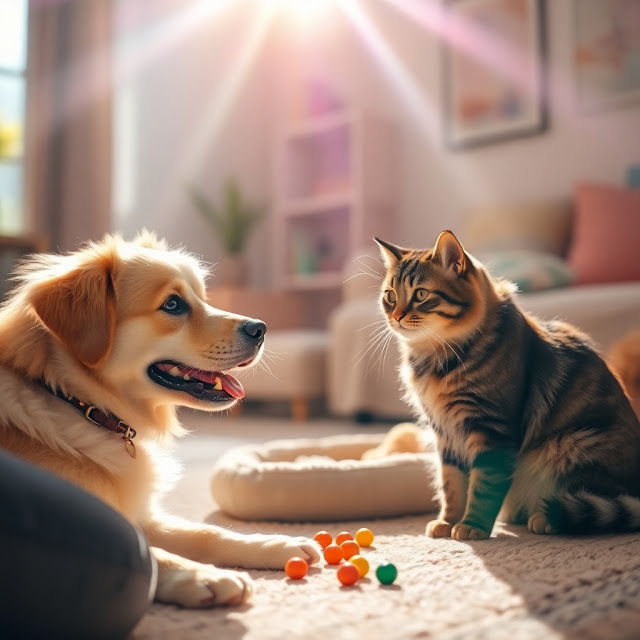How to Socialize Your Dog with Other Animals
How to Socialize Your Dog with Other Animals: The Ultimate Guide
So, your pup thinks every squirrel is a sworn enemy and every cat is plotting world domination? 🐶🐱 No worries! Socializing your dog with other animals is totally possible—with the right approach, patience, and plenty of treats! 🍖✨
If your furry friend turns into a barking mess at the sight of another creature, this guide is for you. Let’s break it down step by step! 🐾
Why Is Socialization Important? 🧐
Proper socialization helps your dog:
Be more confident and less anxious around other animals 🐕
Prevent aggressive or fearful behaviors 🚫
Enjoy playdates, dog parks, and adventures 🌳
Reduce stress in multi-pet households 🏡
Dogs that aren’t socialized properly might become reactive, fearful, or aggressive—which can make life harder for both of you! But don’t stress, we’ll fix that. 😉
Step 1: Start Socialization Early (If Possible) 🐶
If you have a puppy, start socializing ASAP! The critical socialization period is between 3 to 16 weeks old. Expose them to:
Other friendly dogs 🐕
Cats and small animals 🐾
Different environments (parks, sidewalks, pet-friendly stores) 🏙️
Various sounds, people, and objects 🚗🦺
🎉 Goal: Your pup learns that new experiences = fun and safe!
But what if your dog is older? No problem! Adult dogs can still learn—it just takes more patience. 🕰️
Step 2: Understand Your Dog’s Social Skills 📝
Before introducing your dog to other animals, ask yourself: ✅ Are they fearful, reactive, or overexcited around other animals? ✅ Do they have past negative experiences with dogs or cats? ✅ Can they stay calm on a leash when seeing other animals?
Knowing where your pup currently stands helps you create the right socialization plan! 🚀
Step 3: Controlled Introductions 🐕🐈
Meeting Other Dogs 🐶🐶
✔️ Pick a calm, neutral space (avoid your home, as dogs can be territorial). ✔️ Use a leash and keep it loose (tense leashes = nervous dogs!). ✔️ Start at a distance and watch body language—loose tails and wiggly bodies = good, stiff posture and growling = not so good. ✔️ Walk side by side before letting them interact directly. ✔️ Keep sessions short & positive with treats and praise!
🚨 Red Flags: ❌ Stiff body, growling, raised hackles ❌ Intense staring or lunging ❌ Tail tucked, ears pinned back (fearful signs)
If any of these happen, slow down and don’t force interaction!
Meeting Cats & Small Animals 🐕🐱
If your dog has never met a cat (or has a strong prey drive), go slow!
🐾 How to Introduce a Dog to a Cat:
Use a barrier first—let them see each other through a baby gate or glass door.
Reward calm behavior with treats (no barking or lunging = treats & praise!).
Leashed introduction: Once calm, allow short meetings with your dog on a leash.
Supervised off-leash time: Only once they’ve shown consistent calm behavior.
🚨 If your dog chases or fixates on the cat, stop and go back a step.
🐦 For Birds, Rabbits & Other Small Pets: Keep initial meetings through a secure enclosure. Never leave them unsupervised until you fully trust your dog’s behavior!
Step 4: Positive Reinforcement Training 🍖✨
🐾 Teach “Look at Me”: Reward your dog for focusing on you instead of the other animal. 🐾 Use treats & praise for calm behavior near other pets. 🐾 Never punish growling—it’s a warning sign. Instead, remove them from the situation and try again later. 🐾 Short sessions = better results! Keep training fun and stress-free.
Step 5: Supervised Play & Social Time 🏡
Once your dog is comfortable, set up supervised playdates: ✔️ Choose calm, friendly animals for interactions. ✔️ Keep early meetings short (5–10 min max). ✔️ Always monitor body language. ✔️ End on a positive note with treats & praise!
With consistent practice, your dog will build positive experiences and become a social butterfly! 🦋
Step 6: Socialization in Everyday Life 🌎
🎾 Dog Parks: Once your dog is confident, try short visits! Stick to the small dog or less crowded area first. 🦴 Pet-Friendly Stores: Great for low-pressure socialization. 🐕🦺 Walks in Busy Areas: Expose them to other animals from a distance before closing the gap.
🔑 Consistency is key—the more positive encounters, the better!
Step 7: When to Get Professional Help 🐶
If your dog shows extreme fear, reactivity, or aggression, don’t hesitate to get help from a certified dog trainer or behaviorist. They can create a customized training plan to set your pup up for success! 🏆
Final Thoughts: Your Dog CAN Make Friends! 🎉
Socializing your dog with other animals takes time, patience, and positive reinforcement—but it’s so worth it! 🐾❤️
✅ Start slow & observe body language ✅ Use positive reinforcement (treats, praise, patience!) ✅ Keep training fun & stress-free ✅ Celebrate small wins! 🎉
With consistency, your pup will learn to be calm, confident, and social in no time! Got a socialization success story? Share it in the comments below! 🐕🐾











